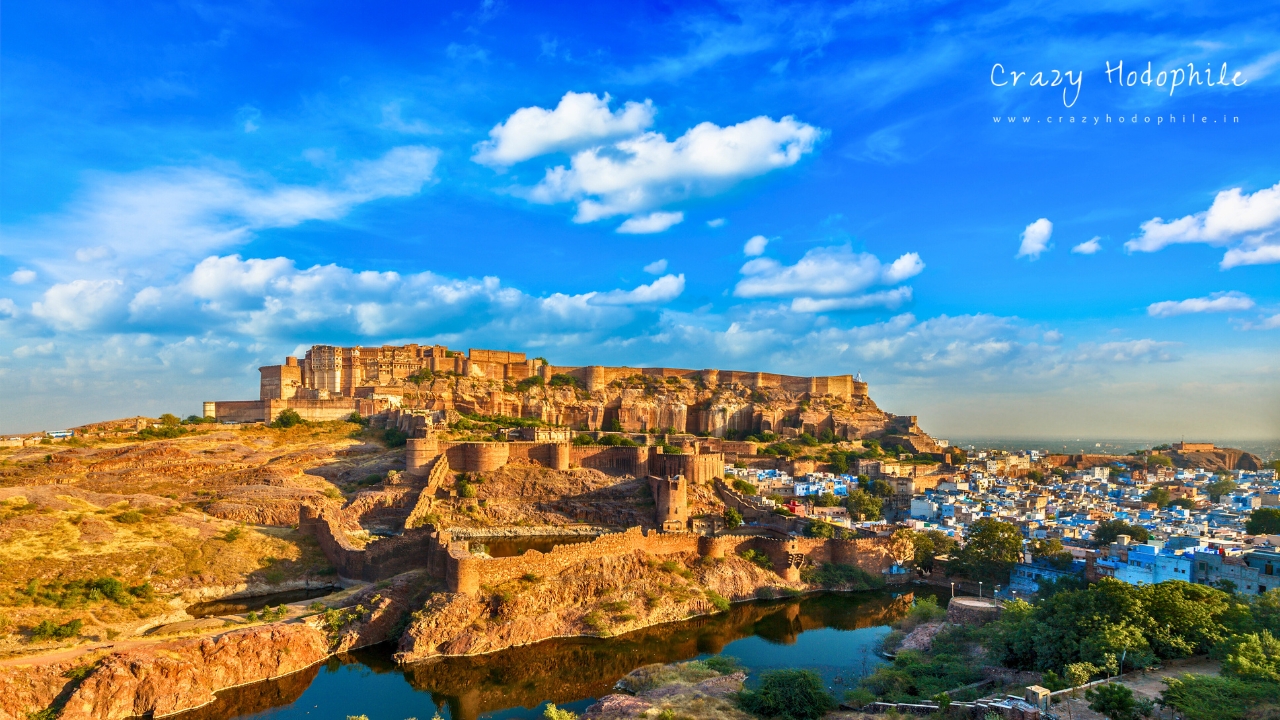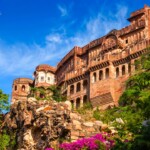Mehrangarh Fort Adventures: From Palaces to Ziplining | Crazy Hodophile | 2025
Mehrangarh Fort, an iconic symbol of Rajasthan’s cultural and architectural grandeur, stands tall as a testament to India’s rich heritage. Overlooking the “Blue City” of Jodhpur from its perch atop the 125-meter-high Bhakurcheeria hill, also known as the “Mountain of Birds,” this colossal structure showcases centuries of Rajputana pride, valor, and artistic excellence.
Table of Contents
History
Founded in 1459 by Rao Jodha, the ruler of Mandore and the visionary behind Jodhpur, the fort was conceived to serve as a safer and strategically elevated capital. Legend has it that a hermit named Cheeria Nathji initially resisted the fort’s construction. Rao Jodha provided a separate dwelling to honor and appease him and called the fort Mehrangarh, or “Citadel of the Sun,” reflecting the Rathore dynasty’s lineage tracing back to the Sun God.
The fort’s construction was an evolving process that spanned over 500 years, with contributions from successive rulers. Encompassing an area of approximately 5 square kilometers, the fort is renowned for its seven gates. Each gate was constructed to commemorate a significant victory, such as the Jai Pol built by Maharaja Man Singh in 1806 to celebrate triumphs over Jaipur and Bikaner, and Fateh Pol, added by Maharaja Ajit Singh in 1707 after defeating the Mughals. These gates stand as lasting testaments to the fort’s rich and layered history.
Mehrangarh Fort Architecture
Mehrangarh Fort is an architectural masterpiece, blending various styles developed over five centuries. Its towering walls, some as high as 120 feet and 70 feet wide, make it one of the most impregnable forts in India. The fort covers an expansive area of 5 km and is accessed through seven massive gates, each with its unique significance.
Key Gates:
- Jai Pol: Built by Maharaja Man Singh to commemorate victories over Jaipur and Bikaner armies.
- Fateh Pol: A mark of triumph over the Mughals.
- Other impressive entrances include Loha Pol (the iron gate fortified with spikes), Dedh Kanghra Pol (also known as Lakhna Pol), Suraj Pol, and Amriti Pol.
Notable Structures:
- Moti Mahal (Pearl Palace): Considered the grandest of Mehrangarh’s palaces, it served as the seat of power for generations of Jodhpur’s rulers.
- Sheesh Mahal (Mirror Palace): A lavishly decorated hall featuring reflective glass mosaics.
- Phool Mahal (Palace of Flowers): A luxurious chamber for royal celebrations, adorned with gold and vibrant murals.
- Jhanki Mahal: From where royal women observed court proceedings.
- Takhat Vilas: The last palace built within the fort, known for its European influences.
- Kirat Singh Soda’s Chhatri: Pay homage to this cenotaph dedicated to a brave warrior who sacrificed his life defending the fort.
- Chamunda Mata Temple: Seek blessings at this ancient temple, dedicated to the fierce goddess Chamunda, the patron deity of the Rathore clan.
Explore the fort’s sprawling courtyards and marvel at its intricate palaces and serene temples. Every corner whispers tales of a bygone era, inviting you to step back in time.
Gallery
Opening Hours
It is open daily from 9:00 AM to 5:00 PM
Best Time to Visit
The best time to visit Mehrangarh Fort is during the winter season, from October to March. Here’s why:
- Pleasant weather
- Festive season
Entry Fee and Other Charges
- Entry Fee: Free
- Museum Entry Fee: ₹ 100 for Indians; ₹ 50 for senior citizens, students, and paramilitary personnel; ₹ 600 for foreigners (includes audio equipment); ₹ 400 for foreign students.
- Photography: Still Camera Fee: ₹ 100; Video Camera Fee: ₹ 200
- Other Fees: Chokelao Bagh Entry Fee: ₹ 30 per person; Elevator (one-way): ₹ 50; Tour Escort Fee: ₹ 120; Audio Guide Fee: ₹ 180; Guide Fee: ₹ 300 to ₹ 600 (varies based on tax)
Mehrangarh Museum Trust Website – https://www.mehrangarh.org/visit/mehrangarh-museum/
Tips for Your Visit
- Visit Early or Late: Arrive in the morning or late afternoon to avoid both the heat and the crowds.
- Wear Comfortable Footwear: The fort’s uneven paths and stairs require comfortable shoes for easy navigation.
- Take a Guided Tour: A local guide can enrich your experience with fascinating insights into the fort’s history and architecture.
- Photography: Check the fort’s photography policies, as some areas may have restrictions or additional fees.
- Explore at Your Own Pace: The fort has many attractions—allow yourself plenty of time to see everything.
- Stay Hydrated: Especially in warmer months, carry water to stay refreshed throughout your visit.
Activities and Experiences
Zip Lining Adventure
- Visitors can enjoy an adrenaline-pumping zip lining experience by Jodhpur Flying Fox. This activity offers stunning aerial views of the fort, its battlements, and the surrounding landscape, including the Rao Jodha Desert Rock Park.
- Timings: 9:00 AM to 5:00 PM
- Duration: 45 to 90 minutes
- Cost: ₹ 1600 onwards, depending on the chosen experience
- Website: https://www.flyingfox.asia/
Mehrangarh Museum
The Mehrangarh Museum houses one of the finest collections of artifacts and decorative arts in Rajasthan. It is divided into several galleries, each showcasing unique aspects of the region’s history and culture:
- Elephant Howdah Gallery: A collection of elaborate elephant seats used by royalty.
- Arms Gallery (Saleh Khana): Showcasing an impressive collection of Rajput weaponry, including swords and armor.
- Textile Gallery: Exhibiting royal attire, including intricately embroidered garments.
- Painting Gallery: Featuring miniature paintings that reflect the artistic traditions of Marwar.
- Turban Gallery: Delve into the world of turbans, an essential part of Rajasthani attire, and learn about their significance and varied styles.
- Daulat Khana Gallery: Discover a collection of royal palanquins, showcasing the intricate craftsmanship and luxurious travel arrangements of the Maharajas.
Cultural Events
The fort hosts vibrant festivals such as the Rajasthan International Folk Festival in October and the World Sufi Spirit Festival in February, celebrating music, dance, and cultural diversity.
Services Tailored for You
- Audio Guides: Audio guides are available in multiple languages. They are an enriching option to explore the fort’s history and significance.
- Elevators: Elevators are available at the fort for visitors who prefer not to climb the steep paths. The one-way elevator ride costs ₹50.
- Cafeteria: Multiple dining options exist within the fort. These include:
- Cafe Mehran: located in the inner courtyard, serves light snacks.
- Palki Cafe: offers open-air seating.
- Vaara Cafe: near the Zenana Gate, is ideal for drinks and snacks.
- Chokelao Mahal Terrace Restaurant: provides a luxurious dinner experience with a view.
- Museum Shop: Visitors can purchase souvenirs and mementos at the museum shop.
- Parking Facility: Ample parking space is available near the fort entrance.
Lesser Known Facts
- The fort has been a filming location for major movies like The Dark Knight Rises (2012) and The Jungle Book (1994).
- Handprints on the fort’s walls commemorate the royal women who performed Sati (self-immolation).
- Every afternoon, a large gathering of eagles can be seen near the fort, creating a mesmerizing spectacle.
- Mehrangarh, meaning “the Citadel of the Sun,” reflects the Rathore clan’s mythical claim of being descendants of the Sun God.
How to Reach
- By Air: The nearest airport is Jodhpur Airport (JDH), about 8 km from Mehrangarh Fort. You can hire a taxi from the airport or take a pre-paid cab to reach the fort.
- By Train: Jodhpur Junction (JU) is the main railway station, well-connected to major cities across India. Taxis and auto-rickshaws are readily available from the station to take you to the fort.
- By Road: Jodhpur is well-connected by road to other cities in Rajasthan and neighboring states. You can either drive your vehicle or take a bus to Jodhpur. Most buses arrive at the Paota Bus Stand or Rai Ka Bagh Bus Stand, which are both centrally located and close to the main tourist area near Mehrangarh Fort.
Location Map for Mehrangarh Fort
Nearby Attractions to Visit
- Jaswant Thada (850 m): A stunning marble cenotaph built in memory of Maharaja Jaswant Singh II.
- Rao Jodha Desert Rock Park (950 m): A unique ecological restoration project adjacent to the fort.
- Ranisar Talab (1 km): A serene lake built to conserve water, offering a peaceful spot near the fort.
- Ghanta Ghar (Clock Tower) (2.5 km): A bustling marketplace surrounding this iconic landmark in the heart of Jodhpur.
- Toorji Ka Jhalra (walking distance is 600m and by vehicle distance is 2.8 km): A beautifully restored stepwell in Jodhpur.
- Umaid Bhawan Palace (6.5 km): A luxurious heritage hotel and museum showcasing royal artifacts.
Related External References:








Great info.
THANKS FOR COMPLIMENTING